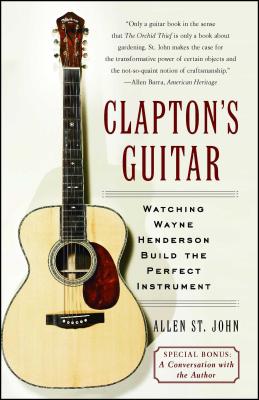Thursday, May 2, 2013
Notes from the Nightstand: Clapton's Guitar
Clapton's Guitar is subtitled, "Watching Wayne Henderson Build the Perfect Instrument," and it is far more about the guitar maker and how he makes his world-class instruments (in addition to a variety of tangential topics both guitar-mythological and -historical) than it is about Eric Clapton. In fact, Clapton comes off as a distant and maybe somewhat pompous rock star, regarded by this clan of Appalachian old-timey flatpickers as an amusing curiosity from the outside world. There is certainly no "Clapton is God" mentality in Rugby, Va. (pop. 7), where Henderson's workshop is located.
Wayne Henderson, retired mailman and grandson of a casket maker (guitars are also just wood boxes, he says), began building guitars as a child. He shows the author the first guitar he ever built - out of a cardboard box - and the first real guitar he built as a teen out of scrap wood from a mahogany door. As a musician himself, he established a reputation for making incredible-sounding, Martin Guitars-inspired instruments among the traditionalists and bluegrassers he played with on the flatpicking contest circuit and later while he worked as a repairman for Gruhn Guitars in Nashville. The two guitars he builds over the course of the book are #326 and #327 of all the guitars Henderson has ever made over the course of a lifetime. Each is a handcrafted piece of art.
Allen St. John, the author, contacts Henderson at the beginning of the book to ask to have a guitar made for himself. All Henderson guitars are made on request and specifically personalized for the buyer. St. John quickly discovers that if you hope to receive a finished Henderson guitar in less than a decade or more, it's in your best interest to make a nuisance of yourself. Guitars get made when a buyer camps out in Wayne's workshop, plying him with pies and jokes and threatening post cards. Wayne Henderson, like any stereotypical artist, works in his own unique time frame.
So St. John plants himself on a stool in Wayne's shop with the other General Loafers, a motley crew of friends and relatives who hang around telling stories and cracking jokes and supplying bags of fast food sausage biscuits while Wayne works. The author is fascinated by Wayne's nonchalance about Clapton's decade-old guitar order, and smelling a good story in the making, convinces the luthier to shift from his own guitar to Clapton's guitar and a twin that can be auctioned off for charity.
In addition to the detailed descriptions of how a fine guitar is made, St. John covers the difference between old-time music and bluegrass, histories of guitar making and guitar makers, a discussion of tonewoods and the scarcity of Brazilian rosewood, the backstories and legends of historic guitars that pass through the shop, and a multitude of other related topics. The passion that some people have for hunting down, collecting, or even just playing these high-end and antique guitars is a constant theme. Every character in the book has an eye out for the next hidden diamond he might get his hands on.
I myself am not a guitar player. Our friend Max, who knows that Mike plays and that we are into traditional music, recommended the book to us. Mike read it first and loved it, so I just had to read it, too. It was a fascinating, quick read. It's never too dry or technical, even when the topics turn to the bending of guitar sides or the serial numbers on old Martins from the '20s. And Wayne Henderson seems like a very likeable, admirable person and a true craftsman. I always love to hear about people who can build something beautiful and useful with their bare hands. Honoring those traditions makes life feel richer and less plagued by soulless modern consumer culture. St. John decides at the end of the book that what makes a guitar great is the goodness of the guitar maker's soul, and a Henderson guitar is an act of love.
Subscribe to:
Post Comments (Atom)



No comments:
Post a Comment
Note: Only a member of this blog may post a comment.